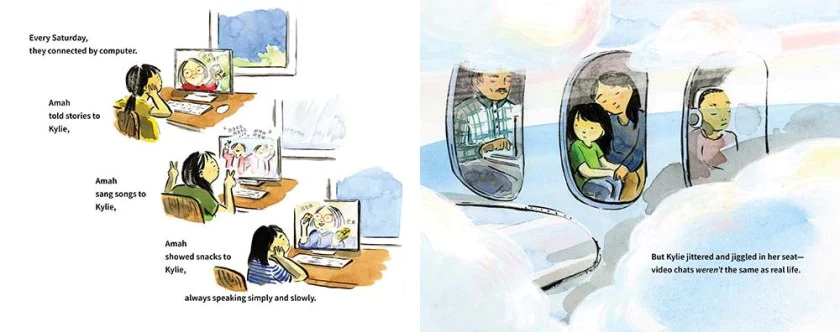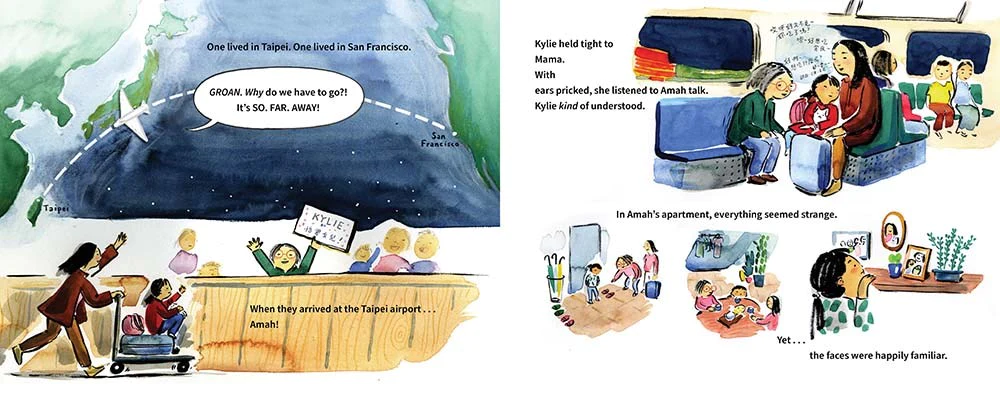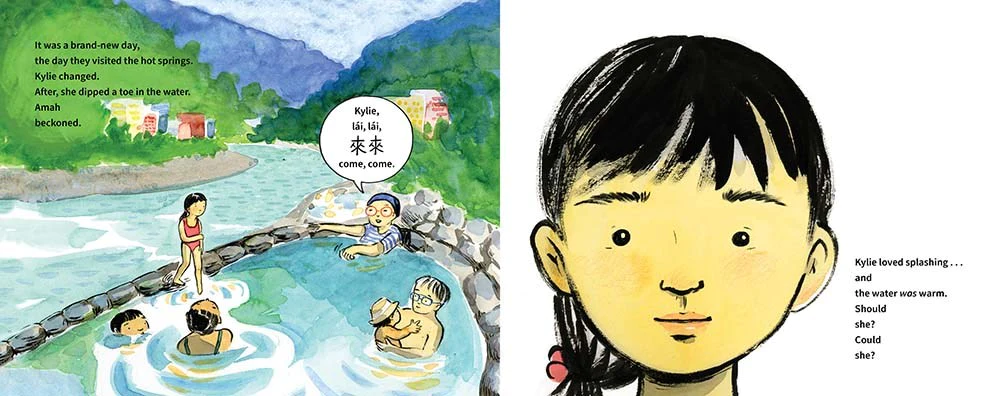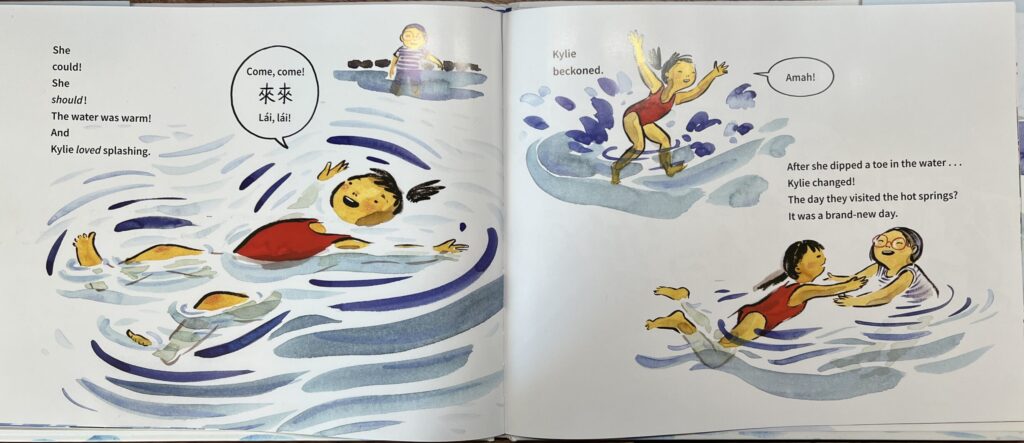I wish I’d picked up a copy of AMAH FARAWAY by Margaret Chiu Greanias and illustrated by Tracy Subisak before I presented to bilingual and ESL educators a couple of weeks ago. This book explores the feeling of living in and between two cultures in a heartfelt but fun and lively way.

Young Kylie lives with her mom in San Francisco while her grandmother, Amah, lives in Taiwan, an ocean away. Although they connect online every Saturday, “…video chats weren’t the same as real life.” One day, Kylie and her mom take the looonnnggg flight across the Pacific to visit Amah. But once they get there, Kylie is hesitant and shy. She doesn’t understand everything her Amah says in Mandarin and is overwhelmed by a large banquet, new foods, and new sights.


The thing that blew my mind about AMAH FARAWAY is its structure. It’s a reverso, also called a reverse poem. Author and poet Marilyn Singer explains in an article, “A reverso is a poem with two halves. In a reverso, the second half reverses the lines from the first half, with changes only in punctuation and capitalization — and it has to say something completely different from the first half.” I have a hard enough time writing a poem that just goes forwards — to write one that is essentially a palindrome is just amazing to me.
In the first half of AMAH FARAWAY, Kylie is uncomfortable and reluctant. “Everywhere they went,/ Kylie/ trailed behind/ Amah and Mama.” Until Amah takes them to the hot springs. This is the turning point of the story and the poem. On the spread below, Kylie is unsure.

But then, she has a change of heart. On the next page, we read the exact same lines as the previous page, but in reverse. And Kylie’s opinion of the hot springs (and Taipei) has done a 180° turn as well.

The rest of the book shows Kylie now leading Amah and Mama around Taipei, ending with a heartwarming and satisfying plane trip of — you guessed it — Amah visiting Kylie in San Francisco.
I love Tracy Subisak’s vivid illustrations, which are done in watercolor, india ink, and pastel. Both Margaret and Tracy have ties to Taipei and it shows in the way the text and art capture the culture and vibrancy of the city and its people. I also love the way Mandarin is incorporated seamlessly into the text and art, presented with Chinese characters, the phonetic pronunciation in Pinyin, and the English translation. Some of the Chinese characters are not translated, such as when Kylie and Amah are chatting over video or when Amah and Mama are talking, which I found to be a fun test of my Chinese reading abilities (which are at a Kindergarten level). Readers who know or are learning Chinese will enjoy reading the characters and maybe recognize some of the things Kylie and Amah say to each other. I laughed when I figured out Amah is singing the “Two Tigers” song to Kylie, because I had to learn that song in Chinese school when I was little.
AMAH FARAWAY is a wonderful example of a “mirrors, windows, and sliding glass doors” book, as defined by Rudine Sims-Bishop. It can spark discussions about immigration, culture, intergenerational relationships, and language, just to name a few topics. It’s also a great mentor text for anyone wanting to try writing a reverse poem. For more info about the author and illustrator, here are their websites: Margaret Chiu Greanias and Tracy Subisak.
The endpapers are too cute not to share! And I love that the one in the front is in English, while the one in the back is in Chinese and Pinyin. More opportunities for learning and discussion!


Edited to add: I forgot to announce the winner of THE SWEETEST SCOOP from my blog post last month. The winner is…Lisa Meyer! Lisa, please look for an email from me. Congrats!

I had no idea about verse in reverse. Already I want to play with it. What a wonderful concept and execution in Amah Faraway! Thank you.
Have fun playing with this poetic form, Vijaya! I’m tempted to try it, too. 🙂
Love this book! Margaret used such a unique structure and Tracy’s illustrations bring it to life perfectly!
I totally agree! It’s a perfect author & illustrator match!
Great review Andrea! The book is amazing! Margaret is my long time critique partner. I’m so happy you all get to read it.
Thanks, Darshana. How fun that you and Margaret are CPs!
Love this book!
Me too! Makes me want to visit Taipei again!
Writing poetry with a high net (i.e. restrictions) can make for some amazing results. And I think this is a fabulous example!
Thanks, Jilanne, I think so too!
Agreed, Andrea! It’s a brilliant structure and a touching and powerful tale. The illustrations are lovely and so complementary too. Loved it!
Glad you loved the book, too!
I put it on hold at my public library.
Yay! Thanks, Loreli. I hope you enjoy it as much as I did!
I love books that gently teach kids about culture and family relationships!
Me too! Thanks for reading my post, Kathy!
I just requested it from my library, kudos to Margaret and Traci! The structure sounds fascinating and ideal for this story.
Thanks for requesting the book, Sue! I hope you love it as much as I do!
I love the idea of writing a reverso but —wow, it sounds hard! Definitely need a copy of this book to study, and loved reading your post.
Thanks, Lynn! The whole idea of reversos still boggles my mind. 🙂
This book looks beautiful! And thank you…excited to get my book!
Yay, congrats!
Going to request this at my library. Thanks!
Awesome, Tina! I think you’ll love this book.
I actually have this book checked out right now! It’s wonderful! Thanks for sharing.
Great minds! 🙂 So glad you like the book, too!
I can’t wait to read and study this brilliant and beautiful book and the reverso writing style! Thank you for shining a light in this and congratulations to all for creating another wonderful book for children!
Such a great book–and you are right, the structure is just really fabulous! 😍